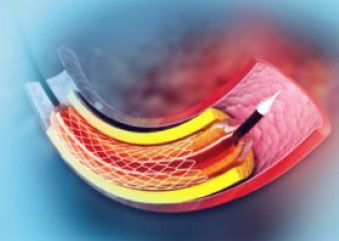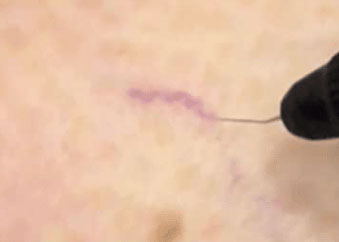
Venous Stenting Treatment
in Traverse City & Cadillac, MI
Venous Stenting
While most venous diseases are due to reflux or nonfunctioning valves in the veins of the legs, venous obstruction can also cause venous disorders. If you think of your veins as hoses taking blood from your legs back to the heart, an obstruction of those veins would be like kinking or pinching off the hose, which is venous stenting. If you’re looking for venous stenting treatment near you, Northern Michigan Vein Specialists in Traverse City and Cadillac, MI, can help!

What Causes Venous Stenting?
This stenosis or obstruction in veins causes pressure to build up upstream, which for the veins, is in the legs. The increased venous pressure leads to leg swelling, edema, heaviness, leg fatigue, varicose veins, and venous ulceration. This narrowing of the veins typically occurs in the pelvis where the iliac arteries cross the veins. Classically, this has been described as May-Thurner syndrome where the left iliac vein is compressed by the right iliac artery, but the veins can be compressed by the arteries at other locations as well. The arteries are under pressure and are therefore much stiffer. This causes the vein to be compressed between the artery crossing over top and the spine under it.
How Can Obstructed Veins Be Treated?
Venous obstruction can also be caused by prior DVT (deep vein thrombosis). In the past the only options for treating these venous obstructions required an open surgery to bypass the obstructed vein. Now venous obstructions can be treated with angioplasty and stenting. A catheter is inserted into the vein under ultrasound guidance. The doctor can then insert a tiny ultrasound into the vein to find and diagnose venous obstructions. This Intravenous Ultrasound or IVUS is the best way to detect venous stenosis and it helps guide treatment options. If significant venous narrowing or stenosis is found the doctor can do angioplasty to stretch the vein back open. After the vein is stretched open, a stent is placed. A stent is a braided metal tube which acts as a scaffold to keep the vein open.
Will My Facial Appearance Be Affected After The Procedure?
Common Post-Treatment Facial Appearance
- Bruising: May occur around the treated site and can last several days or weeks.
- Blistering/Mild Skin Burn/Bumps: May occur resulting from the Ohmic Thermolysis treatment. Usually resolves in a few days, but may last a few weeks, especially after treatment of learge areas.
- Pain: The treated area may be tender to the touch and/or itchy after treatment. This discomfort is usually temporary.
- Scabbing/Sloughing of Skin: The treated area may scab/slough, especially after treatment of large area. Usually resolves in a few weeks.
- Swelling: May occur after treatment. It usually resolves in a few days, but may last a few weeks, especially after treatment of large areas.
- Spider Veins: May occasionally recur in the same or surrounding area.

Why Choose Northern Michigan Vein Specialists for Venous Stenting Treatment?
Dr. Heeringa is the first physician in Northern Michigan to offer IVUS and venous stenting for both post thrombotic and non-thrombotic iliac vein lesions such as May-Thurner syndrome. Discover world-class vein care and venous disease treatment with venous stenting at Northern Michigan Vein Specialists!
